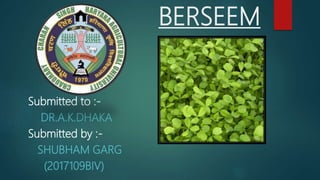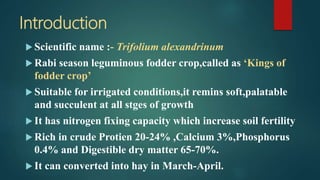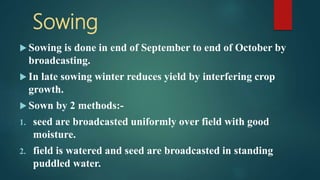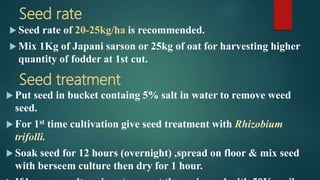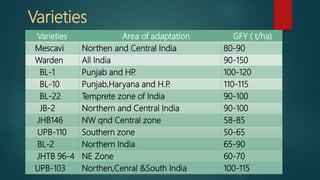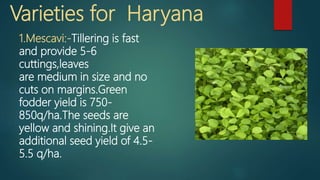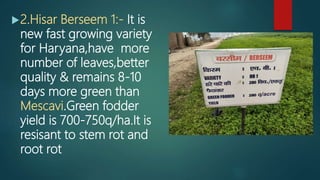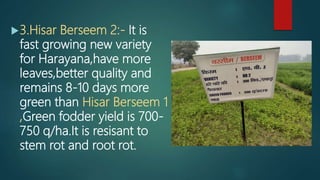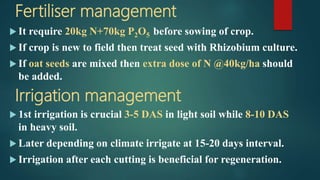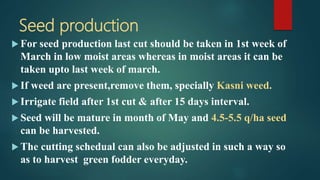Berseem fodder crop production
- 1. BERSEEM Submitted to :- DR.A.K.DHAKA Submitted by :- SHUBHAM GARG (2017109BIV)
- 2. Introduction ’üĄ Scientific name :- Trifolium alexandrinum ’üĄ Rabi season leguminous fodder crop,called as ŌĆśKings of fodder cropŌĆÖ ’üĄ Suitable for irrigated conditions,it remins soft,palatable and succulent at all stges of growth ’üĄ It has nitrogen fixing capacity which increase soil fertility ’üĄ Rich in crude Protien 20-24% ,Calcium 3%,Phosphorus 0.4% and Digestible dry matter 65-70%. ’üĄ It can converted into hay in March-April.
- 3. Origin and Area ’üĄ It is indigenous to Egypt but cultivated in Egypt,Israel,Syria,Persia ,Cyprus,Italy,South Africa, South America,Australia, Pakistan etc ’üĄ It is introduced in India in 1904 from Egypt. ’üĄ It is cultivated around 2 million hectare area,mainly in Punjab,Rajsthan, UP and other part of western India.
- 4. Climatic requirements ’üĄ It require a dry ,cool Climate with a mild temperature for germination and establishment. ’üĄ It grows fast at 18-21OC & suspend growth > 35OC. ’üĄ It cannot be grown in damp,heavy rain,frosty conditions. Soil requirements ’üĄ It can grown on all type of soil except light sandy soil. ’üĄ It cant grown in acidic soil but can grown in saline soil. ’üĄ It can grown at soil pH 7-8.
- 5. Field Preparation ’üĄPlough land 3-4 times with desi plough followed by one soil inversion ploughing. ’üĄOne to two planking should be done to break all soil clods and prepare fine compact seed bed. ’üĄRemove grass,stubble as cause problem later.
- 6. Sowing ’üĄ Sowing is done in end of September to end of October by broadcasting. ’üĄ In late sowing winter reduces yield by interfering crop growth. ’üĄ Sown by 2 methods:- 1. seed are broadcasted uniformly over field with good moisture. 2. field is watered and seed are broadcasted in standing puddled water.
- 7. Seed rate ’üĄ Put seed in bucket containg 5% salt in water to remove weed seed. ’üĄ For 1st time cultivation give seed treatment with Rhizobium trifolli. ’üĄ Soak seed for 12 hours (overnight) ,spread on floor & mix seed with berseem culture then dry for 1 hour. ’üĄ Seed rate of 20-25kg/ha is recommended. ’üĄ Mix 1Kg of Japani sarson or 25kg of oat for harvesting higher quantity of fodder at 1st cut. Seed treatment
- 8. Varieties Varieties Area of adaptation GFY ( t/ha) Mescavi Northen and Central India 80-90 Warden All India 90-150 BL-1 Punjab and HP. 100-120 BL-10 Punjab,Haryana and H.P. 110-115 BL-22 Temprete zone of India 90-100 JB-2 Northern and Central India 90-100 JHB146 NW qnd Central zone 58-85 UPB-110 Southern zone 50-65 BL-2 Northern India 65-90 JHTB 96-4 NE Zone 60-70 UPB-103 Northen,Cenral &South India 100-115
- 9. Varieties for Haryana 1.Mescavi:-Tillering is fast and provide 5-6 cuttings,leaves are medium in size and no cuts on margins.Green fodder yield is 750- 850q/ha.The seeds are yellow and shining.It give an additional seed yield of 4.5- 5.5 q/ha.
- 10. ’üĄ2.Hisar Berseem 1:- It is new fast growing variety for Haryana,have more number of leaves,better quality & remains 8-10 days more green than Mescavi.Green fodder yield is 700-750q/ha.It is resisant to stem rot and root rot
- 11. ’üĄ3.Hisar Berseem 2:- It is fast growing new variety for Harayana,have more leaves,better quality and remains 8-10 days more green than Hisar Berseem 1 ,Green fodder yield is 700- 750 q/ha.It is resisant to stem rot and root rot.
- 12. Fertiliser management ’üĄ It require 20kg N+70kg P2O5 before sowing of crop. ’üĄ If crop is new to field then treat seed with Rhizobium culture. ’üĄ If oat seeds are mixed then extra dose of N @40kg/ha should be added. Irrigation management ’üĄ 1st irrigation is crucial 3-5 DAS in light soil while 8-10 DAS in heavy soil. ’üĄ Later depending on climate irrigate at 15-20 days interval. ’üĄ Irrigation after each cutting is beneficial for regeneration.
- 13. Weed management ’üĄ Main weeds are:- 1)Asphodelus 2)Chenopodium 3)Convovulus 4)Chichorium ’üĄ Berseem is thicky crop so weeding is very difficult process. ’üĄ Weeds also serve as fodder so donot make it necessary to pull them out. ’üĄ The crop matures usually in third week of April so it is critical peroid for weed control.
- 14. Disease management Diseases Casual Organism Symptoms Control Stem Rot Sclerectonia trifoliorum Collar region becmes necrtic with depressed lesions. Stem are gridled at collar region. ŌĆó Avoid excessive irrigation. ŌĆó Spray 0.1%Bavistine twice during Jan-Feb. ŌĆó Select resistant variety HB1. Root Rot Rhizoctonia solani, Fusarium semitacttum Sudden complete wilting of plant within a day. Effected plant can easily be pulled out. ŌĆó Crop sanitation Resistant varieties. ŌĆó Seed treatment with Thiram.Bavistine& Carbofuran@2.5g/kg
- 15. Insect management Pests Symptoms Control Black ants These remove the Germinating seeds Apply Methyl Parathian 2% dust. White grass hopper ŌĆó It damage crop in month of April. ŌĆó 90%insect of other crop damage this crop. ŌĆó Spray Malathion @1lt/ha in 750 lt of water ŌĆó If crop is sown for seed pupose apply 2% Methyl Parathian dust @25kg/ha
- 16. Cuttng management ’üĄCrop should be harvested 55-60 Days after sowing. ’üĄThen subseqent cuts can be taken after every 30-40 days interval. ’üĄIn all 4-6 Cuts are taken with a production of about 750-825 q/ha.
- 17. Seed production ’üĄ For seed production last cut should be taken in 1st week of March in low moist areas whereas in moist areas it can be taken upto last week of march. ’üĄ If weed are present,remove them, specially Kasni weed. ’üĄ Irrigate field after 1st cut & after 15 days interval. ’üĄ Seed will be mature in month of May and 4.5-5.5 q/ha seed can be harvested. ’üĄ The cutting schedual can also be adjusted in such a way so as to harvest green fodder everyday.
- 18. Toxicity ’üĄ A substance known as ŌĆśAstrogenonsŌĆÖ is present in berseem,excess of which makes animal sick and cause ŌĆśBloat diseaseŌĆÖ. ’üĄ Bad effect of this can be reduced if fodder is sprayed with Linseed or Mustard oil. ’üĄ Mixing of dry fodder which contain more fibers like wheat straw also reduces problem of bloating.
- 19. Thank You
